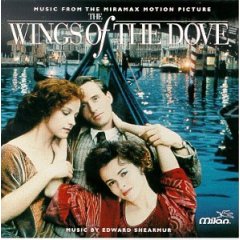

 字體:小 中 大
字體:小 中 大 |
|
|
|
| 2007/02/23 18:45:13瀏覽678|回應0|推薦0 | |
Eaton, Mark. “’Exquisite Taste’: The Recent Henry James Films as Middle-brow.’” Henry James on Stage and Screen. Ed. John R. Bradley. New York: Palgrave, 2000. 157-76.
The Wings of the Dove is the most recent and in some respects the most conventional of the James adaptations, although the director superadds a chancy, un-Jamesian ending to the film. Helena Bonham Carter as Kate Croy – an actress who first came to attention (to American viewers at least) in the Merchant-Ivory production of A Room with a View. Her performance in The Wings of the Dove received widespread acclaim as well as nominations for a Golden Globe and Academy Award (the film garnered additional Oscar nominations for Best Adapted Screenplay, Best Costume Design and Best Cinematography). Softley’s film also did much better business than the two previous James adaptations, but its success should be attributed at least in part to better marketing. No doubt The Wings of the Dove also benefited from the media coverage of a so-called ‘James revival’, coming as it did on the heels of a much ballyhooed Austen revival. Also, The Wings of the Dove was released in time to qualify for Academy Award consideration, and seemed well positioned to make many critics’ lists of best films of the year. It was moreover frequently touted as the ‘best’ –perhaps a shorthand way of saying most watchable – of the James films, and so one could argue that The Portrait of a Lady and Washington Square (both box office failures in comparison) paved the way for a more honorific, less ambitious literary adaptation. P( 169) Iain softly chose to set the film around 1910, just after the completion of the London Underground, and he also made a point of updating the scenery and costume design to reflect that date. In other ways the film is rather conventional. There are no odd camera angles or other stylistic innovations to get in the way of the narrative. Viewers are free to lose themselves in the plot and scenery. There is one overhead shot of Martin Densher on a park bench, waiting for Kate Croy; but for the most part the camera movement does not call attention to itself as it did in the two other films. The city scenes are sumptuously shot, many of them in the beautiful blue light of dusk. But the focus is on the plot: with the arrival of Milly Theale, a potential love triangle develops, and the rest of the film involves the complex dance of mimetic desire between the three principal characters.44 P( 170) Of course, where Softley departs from the novel is in making the film sexually explicit. From the start the relationship between Kate and Martin is eroticised: they grope on an elevator, in a billiard room and in a dark alley during the carnival in Venice. Softley also brings out the homo-erotic potential in Kate’s relationship with Milly—for instance, when they share a bed at Lord Mark’s castle. P( 170) In fact, she is remarkably thin, and the cold blue light from the window substitutes for the usual warm glow of cinematic sex and accentuates her thinness. The scene is also surprisingly quiet, with only the sound of rain and the crackle of a fire where Kate has just deposited Milly’s letter. softly preserves the silence for several minutes before the music starts towards the end of the scene. Predictably, this scene has provoked comment from nearly every reviewer of the film. In The New Yorker, Daphne Merkin stated: ‘The use of full nudity in the scene comes as a shock, but not a particularly effective one…The sight of Kate’s naked body seems imposed on James’s delicately suggestive vision in an unnatural way; it’s both unsettling and unsexy.’47 This closing scene, in any case, serves a double purpose: it brings the putative marriage plot to its non-conclusion and renders visually what James’s prose only implied. The scene ends with the two characters deciding not to marry: too much water has passed under the bridges of Venice for them to sail into the sunset and live happily ever after. As the last line of the novel has it (unfortunately omitted from the film): P( 171) ‘Henry James was writing at the threshold of cinema,’ Ralph Bogardus has observed. P( 172)
47 Daphne Merkin, ‘The Escape Artist: Henry James’s Unfilmable Passion for Renunciation’, The New Yorker, 10 November 1997,122. 49 Ralph Bogardus, Pictures and Texts: Henry James, A. L. Coburn, and New Ways of Seeing in Literary Culture (Ann Arbor, MI: UMI Research Press, 1984), 181. P( 176)
|
|
| ( 知識學習|語言 ) |










